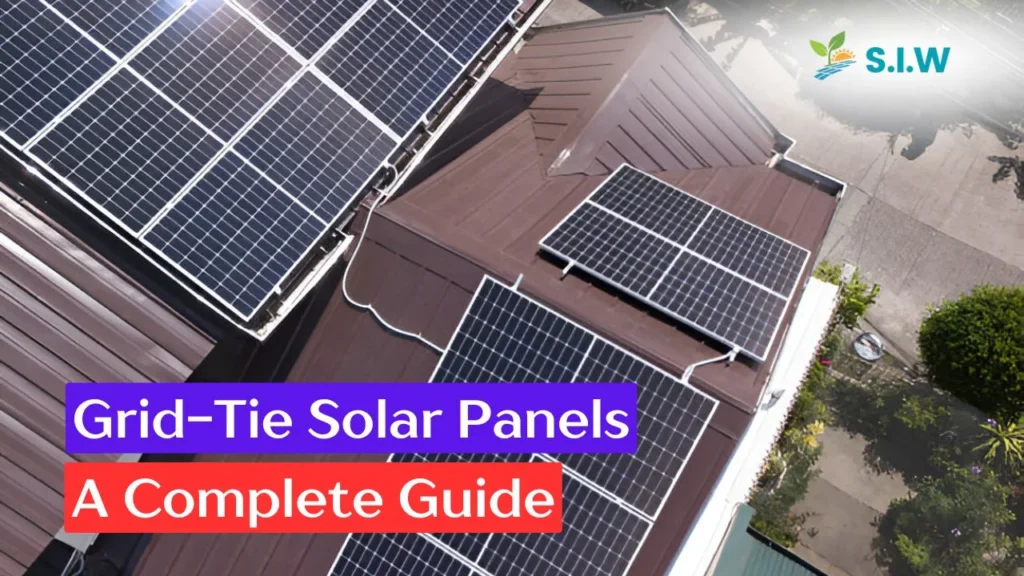Solar energy has emerged as a critical part of the global transition towards renewable energy. More homeowners and businesses are looking to solar to reduce their dependence on fossil fuels and lower their utility bills. Grid-tie solar panels stand out as an effective way to harness solar energy while maintaining access to the main power grid. In a world where energy costs are rising and environmental concerns are at the forefront, grid-tie systems offer a reliable and affordable solution.
In this comprehensive guide, we will explore everything you need to know about grid-tie solar panels, from how they work to the benefits they bring. Whether you’re a homeowner considering solar energy or a business looking to cut down operational costs, grid-tie systems may be the perfect fit.
How Do Grid-Tie Solar Panels Work?
Understanding how grid-tie solar panels work is key to recognizing their value. At their core, these systems rely on photovoltaic (PV) panels to convert sunlight into electricity. The electricity generated is DC (direct current), which isn’t suitable for most home appliances. Here is where inverters come into play.
Inverters are the backbone of any grid-tie system, as they convert DC electricity into AC (alternating current), the type used by homes and businesses. The magic of grid-tie systems lies in their connection to the power grid. When your solar panels generate more electricity than you use, the excess power flows back into the grid, potentially earning you credits on your electricity bill through a process called net metering.
This seamless connection ensures that even during cloudy days or at night, when your solar panels aren’t generating electricity, you still have access to grid power. It’s a perfect balance between renewable energy independence and the reliability of the traditional electrical grid.
Benefits of Grid-Tie Solar Panels
There are numerous benefits to choosing a grid-tie system, starting with significant cost savings. By generating your own electricity and sending the excess back to the grid, your energy bills will be reduced considerably. Additionally, environmental benefits cannot be understated. Grid-tie solar panels help reduce greenhouse gas emissions, decrease reliance on non-renewable resources, and contribute to a more sustainable future.
Another notable benefit is the ease of installation and maintenance. Grid-tie systems do not require the expensive batteries associated with off-grid setups, making them more affordable and simpler to maintain. Furthermore, many governments offer financial incentives, such as tax credits or rebates, which can drastically lower the initial installation cost.
Energy security is another important factor. While grid-tie systems rely on the grid, they still allow you to generate your own electricity. This means that as long as your solar panels are generating energy, you are less dependent on your utility provider, particularly during peak times when energy rates soar.
Key Components of a Grid-Tie System
A grid-tie solar system consists of several key components that work together to provide clean energy to your home or business. These include:
- Solar Panels: The most visible part of any solar system, solar panels capture sunlight and convert it into electricity.
- Inverters: Inverters play a crucial role in converting the DC electricity generated by the panels into AC electricity that can be used by your home.
- Grid Connection: The connection to the main power grid is essential for grid-tie systems, allowing excess electricity to be sent back to the grid.
- Monitoring System: A monitoring system allows you to track your energy production and consumption, ensuring optimal performance from your system.
Each of these components works in harmony to deliver reliable, renewable energy to your home or business while reducing your dependence on the traditional power grid.
Grid-Tie Solar Panels: A Complete Guide
Grid-tie solar panels have become a go-to solution for those looking to make the transition to renewable energy. In this complete guide, we’ve covered the essentials of how grid-tie systems work, the benefits they offer, and the key components that make up the system.
What makes grid-tie solar panels particularly attractive is their flexibility. Whether you’re looking to power your home or business, grid-tie systems provide a dependable and environmentally friendly way to generate electricity. With government incentives, financial savings, and the satisfaction of reducing your carbon footprint, grid-tie solar panels are an investment in both your future and the planet.
FAQs
What is a grid-tie solar panel system?
A grid-tie solar panel system is designed to generate electricity from solar energy while staying connected to the main power grid, allowing excess electricity to flow back to the grid and offset utility costs.
Do I need batteries for a grid-tie solar system?
No, batteries are not required for a grid-tie system, as it relies on the grid for power storage and distribution.
How does net metering work?
Net metering allows solar panel owners to send excess energy back to the grid, earning credits that reduce their electricity bills.
Can I install a grid-tie solar system myself?
While it’s possible to install a system yourself, professional installation is recommended to ensure safety, compliance, and optimal performance.
What are the main advantages of grid-tie solar panels?
The main advantages include cost savings, environmental benefits, easy installation, and the ability to earn credits through net metering.
What happens during a power outage with a grid-tie system?
In most cases, grid-tie systems shut down during outages for safety reasons unless a battery backup or hybrid system is installed.
In conclusion, grid-tie solar panels are a practical, sustainable, and financially rewarding solution for anyone looking to embrace renewable energy. They offer a perfect balance between independence and reliability, all while reducing electricity costs and contributing to a cleaner environment. With the right system in place, you can enjoy the benefits of solar energy for decades to come.








